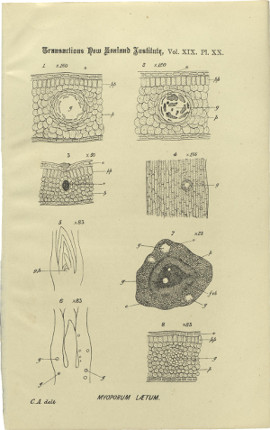Catherine Alexander

First known woman to publish a paper in the Royal Society Te Apārangi's Transactions (1862-1928)
When the New Zealand Institute (what Royal Society Te Apārangi was formerly called) held its inaugural meeting at the Colonial Museum in Wellington in 1868 the room was thronged, including with many young ladies.1 In the years that followed, women held membership in New Zealand’s various regional scientific societies, but it wasn’t until 1886 that a paper read by a woman appeared in the Royal Society's Transactions and Proceedings of the New Zealand Institute. This was Catherine Alexander’s work on the pellucid glands in the leaf and stem of the Ngaio tree. Three more papers by women followed in 1892.
Alexander was an early female student at Canterbury College, and received an Exhibition Scholarship to carry out work for an honours degree in botany.2 Her paper was read before the Wellington Philosophical Society in 1886. By this time, Alexander was already teaching high school, a career followed by most of the educated women in her day. Like many of the early New Zealand women in science, she also seems to have never published again.
Image source: Transactions and Proceedings of the New Zealand Institute
References:
1. John E. Martin, Illuminating Our World: 150 Years of the Royal Society Te Apārangi, 2017, p. 16
2. Mary R. S. Creese and Thomas M. Creese, Ladies in the Laboratory III: South African, Australian, New Zealand, and Canadian Women in Science: Nineteenth and Early Twentieth Centuries (Scarecrow Press, 2010), p. 82.
This profile is part of the series 150 Women in 150 Words that celebrates women’s contributions to expanding knowledge in New Zealand, running as part of our 150th Anniversary.
